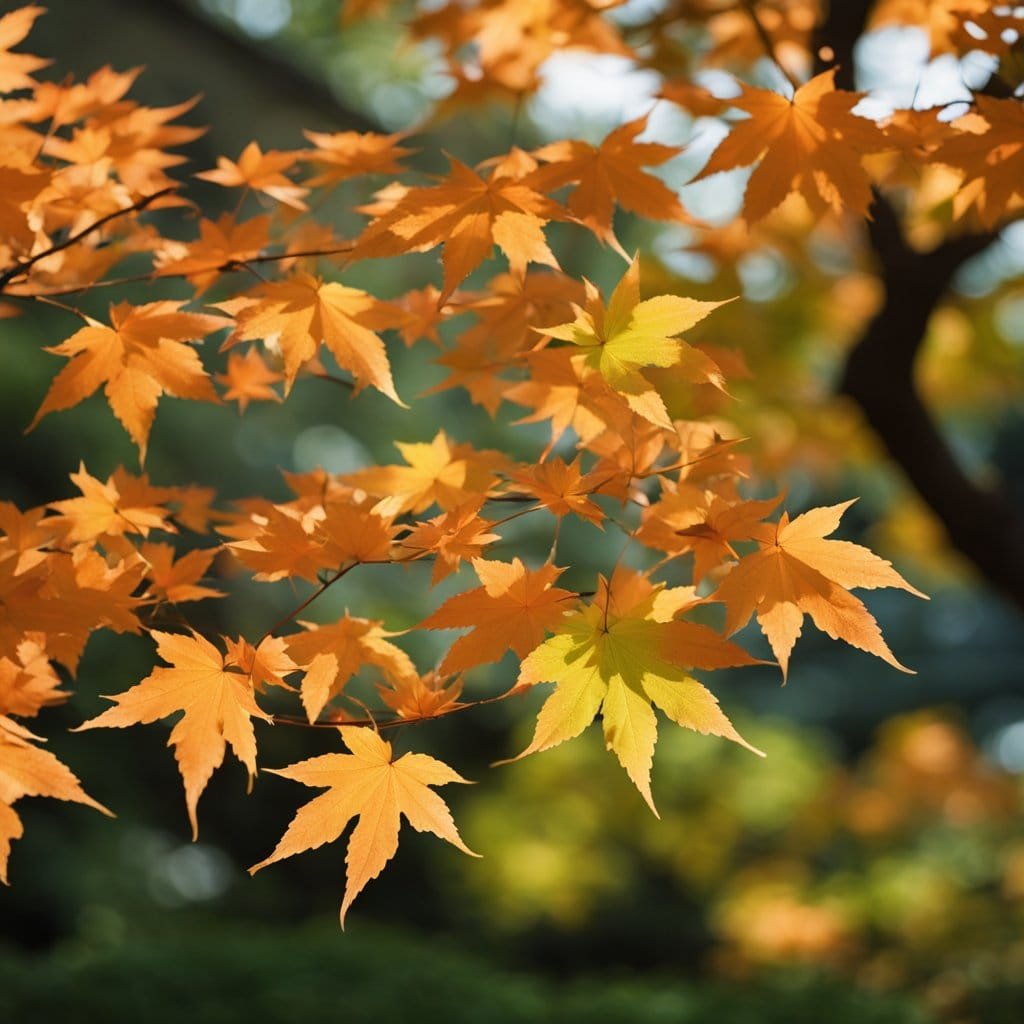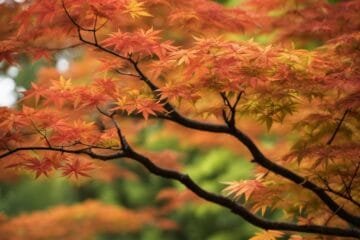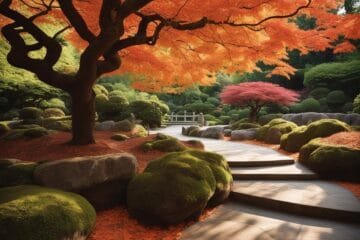
Acer Japonicum Types: Exploring Varieties and Characteristics
Acer japonicum, a notable species of Japanese maple, offers a diverse range of captivating varieties. These trees have beautiful leaves and they change magnificently across the seasons, making them a favorite in many gardens.

Understanding the various Acer japonicum types allows gardeners to choose the perfect tree for their landscape. With vibrant colors and unique shapes, these trees not only add beauty but also provide a focal point that can enhance any outdoor space.
Acer japonicum ‘Aconitifolium’, commonly known as the Full Moon Maple, is admired for its elegant and deeply cut leaves. It stands as a small tree or a large deciduous shrub.
During spring, the leaves emerge bright green, creating a fresh look. By autumn, the foliage transforms into a stunning display of ruby-crimson colors, making it highly sought after for fall gardens.
The tree thrives best in climates with moderate to cool summers. It prefers full sun to partial shade and is an excellent choice as an understory accent in wooded or shaded garden settings.
| Characteristic | Details |
|---|---|
| Leaf Color | Bright green in summer, ruby-crimson in fall |
| Hardiness Zone | USDA zones 5-8 |
| Form | Rounded, small tree or bushy shrub |
| Height | 8-10 feet (2.4-3 meters) |
Acer japonicum ‘Fairy Lights’
Acer japonicum ‘Fairy Lights’ is a popular choice among garden enthusiasts. This variety is notable for its compact size, making it ideal for small gardens. It typically grows to about 5 feet tall over ten years.
The tree’s lush leaves start as light green in spring, turning deeper green during summer. In the fall, the foliage transforms into vibrant colors, creating a dazzling display. ‘Fairy Lights’ thrives in a range of conditions, preferring well-drained soil and partial shade.
Originating from the Yasmina Rare Plant Nursery in Australia, it is known for its dwarf form. It attracts beneficial insects and birds, making it a lively addition to any garden. This tree does well in zones 5-9, showing adaptability to different climates.
| Characteristic | Details |
|---|---|
| Leaf Color Summer | Light to Deep Green |
| Leaf Color Fall | Vibrant Variegations |
| Hardiness Zone | Zones 5-9 |
| Form | Dwarf, Upright |
| Height (10 years) | Approximately 5 ft |
Acer japonicum ‘Vitifolium’
Acer japonicum ‘Vitifolium’ is another popular variety of the japanese maple tree. The leaves have a unique shape that resembles grape leaves, making it a popular choice among gardeners.
In the spring, the leaves emerge with a bronze hue. As the season progresses, the leaves turn a deep green. By fall, they transform into vibrant shades of gold, crimson, and vivid scarlet.
This plant is a deciduous shrub or small tree. It possesses an upright, bushy form that becomes broader over time. ‘Vitifolium’ can reach a height of 10 to 15 feet but occasionally grows taller.
It thrives in hardiness zones 5 to 7. The Full Moon Maple often develops a multi-trunked structure, adding to its ornamental appeal.
| Characteristic | Details |
|---|---|
| Leaf Color Summer | Deep Green |
| Leaf Color Fall | Gold, Crimson, Scarlet |
| Hardiness Zone | 5-7 |
| Form | Upright, Bushy |
| Height | 10-15 feet (occasionally 20 feet) |
Acer japonicum ‘Meigetsu’
Acer japonicum ‘Meigetsu’ is, just like the Aconitifolium, known for its impressive full moon-shaped leaves. In the spring, it starts with light green leaves, which become darker as summer arrives.
In the fall, ‘Meigetsu’ showcases a spectacular display of bright orange and red hues. This tree grows well in well-drained soil, with a preference for sun or partial shade.
It typically reaches a height of 10 to 15 feet. This makes it suitable for small gardens. ‘Meigetsu’ is hardy in zones 5 to 9, which means it can withstand various climates.
| Characteristic | Details |
|---|---|
| Leaf Color Summer | Dark Green |
| Leaf Color Fall | Bright Orange and Red |
| Hardiness Zone | 5-9 |
| Form | Upright, Rounded |
| Height | 10-15 feet |
| Soil Preference | Well-drained |
| Sun Preference | Sun to Partial Shade |
Acer japonicum ‘Green Cascade’
Acer japonicum ‘Green Cascade’ is a remarkable type of Japanese maple known for its distinctive weeping form. It creates a mounded, cascading appearance, similar to a waterfall. The leaves are finely dissected and start as a lush green in spring.
As the seasons change, the foliage transforms into stunning shades of yellow, orange, and red in the fall. This vibrant display makes it a favored choice for gardens.
This variety grows well in Zones 5-9 and prefers well-drained soil. It can tolerate both sun and partially shaded areas. Over ten years, it typically reaches a height of 4-5 feet and a width of 6-8 feet.
| Characteristic | Detail |
|---|---|
| Leaf Color (Summer) | Emerald Green |
| Leaf Color (Fall) | Yellow, Orange, Crimson |
| Hardiness Zone | 5-9 |
| Form | Weeping, Mounded |
| Height | 4-5 feet |
| Width | 6-8 feet |
Acer japonicum ‘Spring Delight’
Acer japonicum ‘Spring Delight’ is a real eye-catcher, mainly for its unique leaves. In spring, its orbicular leaves emerge bright green, often with delightful red tips. These leaves create a beautiful display that changes throughout the seasons.
By summer, the foliage turns a vivid green, providing a lush appearance in any garden. As autumn approaches, the leaves transform, showcasing a dazzling range of bright orange hues.
This maple is well-suited for gardens in hardiness zone 5 and can be planted in sun to partial shade. It reaches an average height of around 7 feet and can spread about 10 feet wide. Its form is cascading, giving it a graceful look in landscapes.
| Characteristic | Description |
|---|---|
| Leaf Color in Summer | Vivid Green |
| Leaf Color in Fall | Bright Orange |
| Hardiness Zone | 5 |
| Form | Cascading |
| Height | 7 feet |
Acer japonicum ‘Ruby’
Acer japonicum ‘Ruby’ is a stunning type of Japanese maple. Its foliage begins as a deep, black-red color in the early spring. By late spring, the leaves brighten before transitioning to a bronze-green shade in summer.
In autumn, the tree puts on a vivid display with orange, red, and purple hues. This cultivar grows slowly, eventually reaching a height of about 2.5 meters. It makes an attractive specimen in both gardens and containers.
This maple thrives in moist, well-drained soil and is hardy in various climates, making it versatile for many landscapes.
| Characteristic | Description |
|---|---|
| Leaf Color Summer | Bronze-green |
| Leaf Color Fall | Orange, Red, Purple |
| Hardiness Zone | 5-7 |
| Form | Upright |
| Height | Up to 2.5 meters |
| Growth Rate | Slow |
Acer japonicum ‘Yama kagi’
Acer japonicum ‘Yama kagi’ is another beautiful kind of maple tree. It has large leaves, almost double the size of an average man’s hands, with a deeply lobed and serrated shape. The leaves emerge bright green and turn a darker shade as the season advances.
In fall, ‘Yama kagi’ offers a spectacular display of oranges, yellows, and bright reds. This large-growing Japanese maple can make a striking addition to any garden landscape. It can reach up to 16 feet tall at maturity, creating a round, umbrella-shaped canopy.
The name ‘Yama kagi’ translates to “Mountain Shadows.” This tree is suitable for hardiness zones 5 to 7.
| Characteristic | Description |
|---|---|
| Leaf Color (Summer) | Bright Green to Dark Green |
| Leaf Color (Fall) | Yellows, Oranges, Bright Reds |
| Hardiness Zone | 5 to 7 |
| Form | Upright, Rounded Umbrella Shape |
| Maximum Height | 14-16 feet |
| Maximum Width | 6-8 feet |
Acer japonicum ‘Shidare-yama’
Next up is the Acer japonicum ‘Shidare-yama’. This tree has a weeping form, making it a standout in any garden.
Its leaves have a vibrant green color in the summer, transitioning to deep red in the fall. These changes add dramatic flair to outdoor spaces.
This maple thrives best in USDA hardiness zones 5 through 7. It typically grows to a height of 10 to 15 feet, making it a medium-sized tree that’s great for gardens.
| Characteristic | Description |
|---|---|
| Leaf Color Summer | Green |
| Leaf Color Fall | Deep Red |
| Hardiness Zone | 5-7 |
| Form | Weeping |
| Height | 10-15 feet |
Acer japonicum ‘Hinode nishiki’
Acer japonicum ‘Hinode nishiki’ is a captivating variety of Japanese maple also known, how could it be any different, for its striking leaf colors. In summer, the leaves display a soft green hue, which transforms into vibrant shades of red and orange during the fall season. This feature makes it a favorite for adding color to landscapes.
It is an adaptable tree, typically thriving in hardiness zones 5 through 7. The form of ‘Hinode nishiki’ is traditionally multi-trunked, allowing it to grow as a small tree or large shrub. It reaches a mature height of about 15 to 20 feet, which makes it suitable for gardens of various sizes.
To maintain its vivid colors and healthy growth, ‘Hinode nishiki’ prefers well-drained soil and partial shade. It can adapt to full sun conditions if the soil is kept moist.
| Characteristic | Details |
|---|---|
| Leaf Color (Summer) | Soft Green |
| Leaf Color (Fall) | Red and Orange |
| Hardiness Zone | 5-7 |
| Form | Multi-trunked |
| Height | 15-20 feet |
Frequently Asked Questions
Acer japonicum exhibits unique features and multiple varieties, each with distinct characteristics. Care requirements and recognition of different types are key elements to understand when considering these trees for gardens.
What are the distinct characteristics of Acer japonicum compared to other maple species?
Acer japonicum, also known as the Full Moon Maple, is notable for its broad, rounded foliage and vibrant fall colors. Unlike Acer palmatum, this species tends to have larger leaves and a more robust branching structure, making it ideal for visual impact in landscapes.
How can one differentiate between varieties within the Acer japonicum species?
Different varieties of Acer japonicum, such as ‘Aconitifolium’ and ‘Vitifolium,’ can be identified by their unique leaf shapes and fall colors. ‘Aconitifolium’ features deeply cut, fern-like leaves, while ‘Vitifolium’ is recognized for its larger leaves and striking autumn hues.
What are the specific care requirements for Acer japonicum ‘Vitifolium’?
Acer japonicum ‘Vitifolium’ requires well-drained soil and partial to full sun exposure. It benefits from regular watering, especially during dry periods, and needs protection from strong winds to prevent leaf damage. Mulching around the base helps to retain moisture and regulate soil temperature.
Which factors should be considered when choosing an Acer palmatum tree for a garden?
Selecting an Acer palmatum tree involves considering the climate zone, the amount of available sunlight, soil conditions, and space for growth. Different varieties may require specific conditions to thrive, so it is crucial to match the plant’s needs with the garden’s environment.
How many types of Japanese maple are recognized by botanists?
Botanists recognize three main species of Japanese maples: Acer palmatum, Acer japonicum, and Acer shirasawanum. Japanese maples consist of various cultivars and hybrids within these species, each offering unique aesthetics and characteristics suitable for diverse landscapes.
What are the prominent differences between Acer japonicum and Acer shirasawanum?
Acer japonicum and Acer shirasawanum differ primarily in leaf shape and growth habits. While Acer japonicum has broad, rounded leaves, Acer shirasawanum, often called the Moon Maple, displays more compact, umbrella-shaped foliage. Both species provide beautiful fall colors but can vary in size and form.










